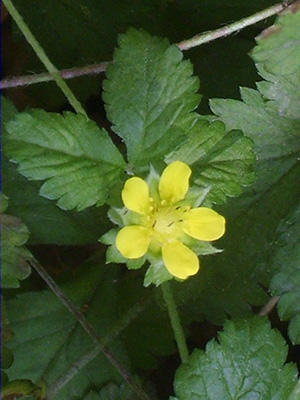False Strawberries (Potentilla indica)
False Strawberries (Potentilla indica)
By Environmental Management System
November, 2011

When people think about Fragaria spp they immediately conjure visions of a large, red juicy, delicious, chin-wiping delicacy. That’s right a strawberry. These are the cultivated varieties that make our mouths water, but what about the wild berries that most of us recognized from childhood? In our yards, we’d find the three leaf plants year round and in the spring they’d have yellow flowers, and then shortly thereafter red berries about the size of your fingernail. These are the Indian or False Strawberries. Have you tried to eat them for most kids have? Delicious, juicy, palatable, well probably not unless you moonlight as a bird or turtle? Some guides say that they are poisonous but that’s false, a bellyache maybe if you eat too many.
Believe it or not, this little fellow is an exotic invasive in many areas. It’s believed to have originated in China and Japan and the tropical Asian region of India and Southeast Asia. They were introduced here by the USDA.
It’s known as Potentilla indica, previously as Duchesnea indica for its ability to multiple by stolons (above ground runners) and root as new plantlets at the nodes. This little strawberry can cause the homeowner some headaches by its growth habit. Over one summer, it can produce a network of plants that continue to grow during mild winters. It’s common to have plantlets every four to six inches in several directions. Pull on one plantlet and it’s liable to break before the next plantlet detaches. You end up getting one and leaving the rest. It’s frequently seen in yards and gardens, and can becomes a ground cover if not controlled. It’s not dangerous unless you have a bad back.
References



